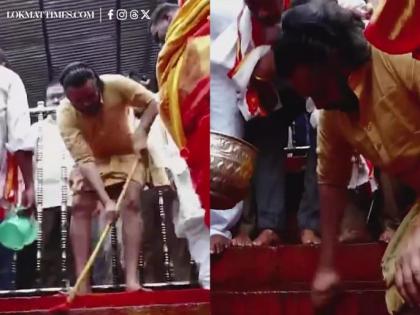Tirupati Laddu Controversy: Know the 4-Hour Purification Havan Vidhi and It's Spiritual Significance
By Lokmat English Desk | Updated: September 24, 2024 16:41 IST2024-09-24T16:40:37+5:302024-09-24T16:41:42+5:30
The Tirumala Tirupati Venkateswara Temple recently underwent a series of purification rituals following a controversy surrounding its famous laddu ...

Tirupati Laddu Controversy: Know the 4-Hour Purification Havan Vidhi and It's Spiritual Significance
The Tirumala Tirupati Venkateswara Temple recently underwent a series of purification rituals following a controversy surrounding its famous laddu prasadam (offerings). In response, temple authorities conducted a four-hour homam (fire ritual) and other Vedic rites to restore the sanctity of the laddu prasadam.
These rituals, which included the purification of the temple premises and the preparation area for the laddus, were designed to eliminate any negative influences and ensure the prasadam’s purity. The purification rituals were performed by 600 Brahmin priests and involved the chanting of Vedic mantras.
The laddu prasadam, a sacred sweet offering made from besan (gram flour) and ghee, is highly revered by devotees. According to temple officials, the laddus are now pure and fit for offering to the deity. The temple authorities believe these rituals have effectively cleansed the premises and restored the sanctity of the laddu prasadam.
Also Read: Tirupati Laddu Controversy: Devotee from Telangana Claims Tobacco Found in Prasad (Watch Video)
The laddu prasadam, also known as the Shrivari Laddu, has a long and sacred history. Temple records date its offering as far back as 1480, when it was originally called 'Manoharam.' The ladoos are considered to be created by Lakshmi herself and carry divine significance.
In the larger spiritual context, devotees of Tirupati Balaji believe they are continuing to pay off Kubera’s debt to the deity through offerings, further emphasizing the importance of the laddu prasadam. The ladoos themselves are produced in enormous quantities—between 3 and 5 lakh per day—generating over Rs 500 crore in revenue annually. The ingredients include 10 tons each of besan and sugar, 700 kg of cashew nuts, 150 kg of cardamom, 300–400 liters of ghee, 500 kg of pak, and 540 kg of manuka (raisins).
The four-hour purification ritual, held from 6 to 10 am in the Yajnashala of the Tirumala Temple, followed the 'Vaikhanasa Agama' principles. The ceremony involved Sankalpa, Vishvaksena Aradhana, Punyahavachanam, Vastu Homam, Kumbha Pratishtha, and Panchagavya Aradhana, culminating in Poornahuthi and Kumbha Prokshan, where special offerings were made to cleanse and purify the space.
Despite the laddu-making process, known as 'Dittam,' changing only six times in the last 300 years, the temple has maintained its rigorous standards to ensure that the laddus remain pure and sacred. Last year, 3.6 million sweets were sold during the 10-day Vaikunthadwara Darshan.
The purification rituals serve to cleanse and sanctify both the temple and its offerings, addressing the spiritual purity of the mind, soul, and body. When a place is deemed unholy, rituals like these, involving holy water from sacred rivers and powerful Vedic chants, are essential in restoring its sacredness.
Key purification rituals performed included:
- Vastu Shuddhikaran: Purification of the temple's architecture and structure.
- Kumbhajala Samprokshan: Purification using consecrated water.
- Yajnashala Shanti: Peace rituals in the yajnashala (sacrificial hall).
- Panchagavya Aradhana: Worship using a mixture of five sacred products from cows.
- Maha Shanti Homam : A grand peace-seeking fire ritual.